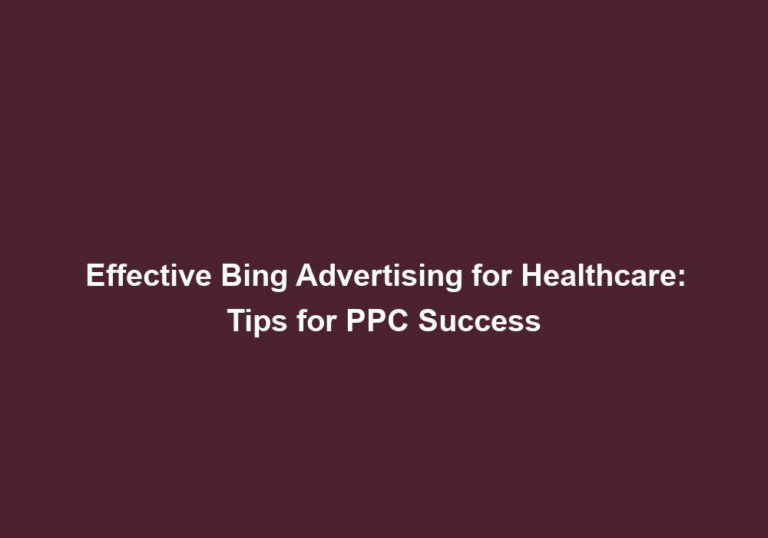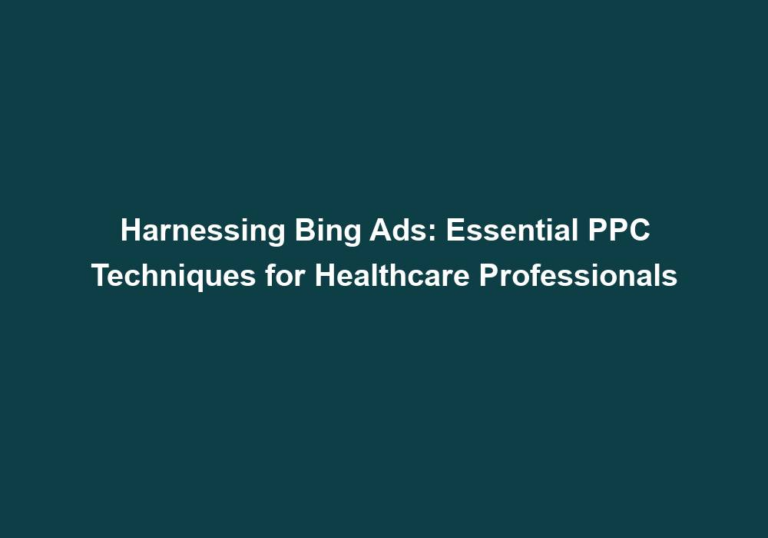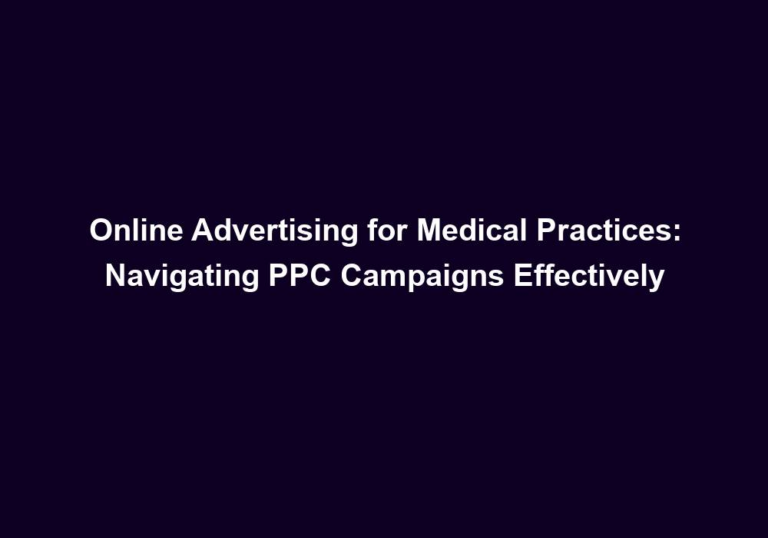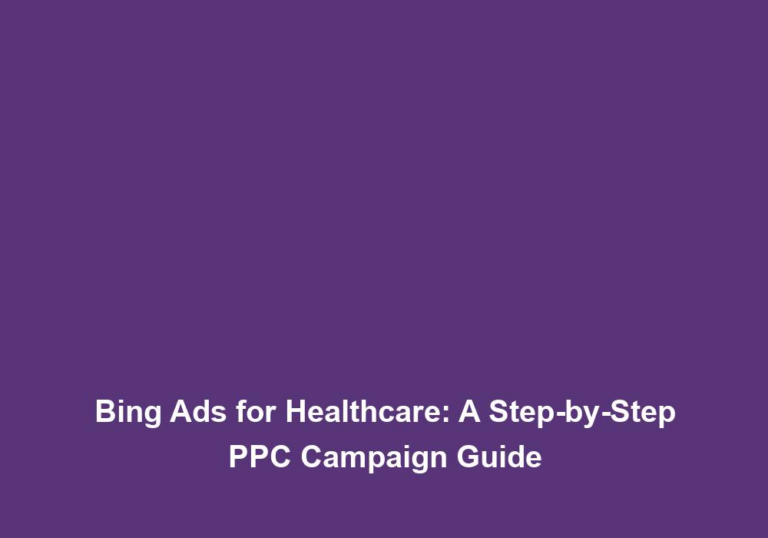Google Ads Mastery for Healthcare: Optimize Your PPC Campaigns
In the ever-evolving digital landscape, Google Ads has emerged as a powerful tool for healthcare providers to reach their target audience effectively. Pay-Per-Click (PPC) campaigns, specifically tailored for the healthcare industry, can drive qualified traffic to your website and ultimately increase patient acquisition. To make the most out of your PPC campaigns and achieve optimal results, it is crucial to master the art of Google Ads. In this article, we will explore the key strategies and best practices to help you optimize your healthcare PPC campaigns.
Understanding the Importance of Google Ads in Healthcare Marketing
Google Ads, formerly known as Google AdWords, is an online advertising platform that allows businesses to create and display ads on Google’s search engine results page (SERP). With billions of searches conducted on Google every day, this platform provides healthcare providers with a valuable opportunity to reach potential patients actively searching for medical services.
By using Google Ads, healthcare practices can target specific keywords and demographics, ensuring their ads are displayed to the most relevant audience. This targeted approach not only increases the chances of attracting potential patients but also improves the overall return on investment (ROI) for your marketing efforts.
Benefits of Using Google Ads in Healthcare Marketing
- Reach a large audience: Google Ads allows you to tap into the vast user base of Google, ensuring that your ads are seen by a wide range of potential patients.
- Target specific keywords: By targeting relevant keywords, you can ensure that your ads appear in front of users who are actively searching for healthcare services.
- Control your budget: With Google Ads, you have full control over your advertising budget. You can set daily or monthly limits to ensure that your spending stays within your desired range.
- Measure your results: The platform provides detailed analytics and conversion tracking, allowing you to measure the effectiveness of your campaigns and make data-driven decisions.
Conducting Thorough Keyword Research
Keyword research forms the foundation of any successful PPC campaign. By understanding the keywords that your potential patients are using to search for healthcare services, you can optimize your ad campaigns to appear prominently in relevant search results. Conducting thorough keyword research involves the following steps:
- Start with a broad list of keywords related to your healthcare specialty.
- Utilize keyword research tools such as Google Keyword Planner, SEMrush, or Moz to identify high-volume, relevant keywords.
- Analyze the competition and search trends for each keyword to determine its viability.
- Refine your list by selecting keywords that have a high search volume, low competition, and strong relevance to your healthcare services.
By identifying the most effective keywords for your PPC campaigns, you can ensure that your ads are seen by the right audience, leading to increased website traffic and patient inquiries.
The Importance of Long-Tail Keywords in Healthcare PPC Campaigns
In addition to targeting broad keywords, it’s also essential to include long-tail keywords in your PPC campaigns. Long-tail keywords are more specific and typically have less competition, allowing you to reach a highly targeted audience. For example, instead of targeting the keyword “dentist,” you could target “pediatric dentist in [your location].” This approach ensures that your ads are shown to users who are actively seeking the specific healthcare services you offer.
Using Negative Keywords to Improve Ad Relevance
Negative keywords are an essential tool in optimizing your PPC campaigns. These are keywords that you don’t want your ads to appear for. By adding negative keywords to your campaign, you can exclude irrelevant search terms, ensuring that your ads are shown only to users who are likely to be interested in your services. For example, if you’re a pediatric dentist, you may want to add “orthodontics” as a negative keyword to avoid showing your ads to users searching for orthodontic services.
Crafting Compelling Ad Copy
Once you have identified the target keywords for your campaigns, the next step is to create compelling ad copy. Remember, your ad copy should be concise, persuasive, and relevant to the user’s search intent. Here are some best practices to keep in mind:
- Use the target keyword in your headline to make your ad more relevant and attention-grabbing. For example, if you’re targeting the keyword “pediatric dentist,” your headline could be “Expert Pediatric Dentist Services.”
- Highlight the unique value proposition of your healthcare practice in the ad description. What sets you apart from your competitors? Why should potential patients choose your services? Focus on these unique selling points.
- Include a strong call-to-action (CTA) that encourages users to take the desired action, such as scheduling an appointment or requesting more information. For example, “Book Your Appointment Today” or “Call Now for a Free Consultation.”
- Test different variations of your ad copy to identify the most effective messaging for your target audience. Experiment with different headlines, descriptions, and CTAs to find what resonates best with your potential patients.
Crafting compelling ad copy not only improves the click-through rate (CTR) of your ads but also increases the likelihood of converting potential patients into actual patients.
Utilizing Ad Extensions to Enhance Ad Visibility
Ad extensions are additional pieces of information that you can add to your ads to provide more context and increase their visibility. These extensions can include phone numbers, links to specific pages on your website, additional text, or even reviews. By utilizing ad extensions, you can make your ads more informative and appealing to potential patients, increasing the chances of them clicking on your ads.
Optimize Landing Pages for Conversion
Driving traffic to your website is just the first step; your landing pages play a critical role in converting that traffic into patients. To optimize your landing pages for conversion, consider the following tips:
- Align your landing page content with the ad copy to provide a consistent user experience. Make sure that the messaging and value proposition mentioned in your ad are reflected on your landing page.
- Ensure that your landing page has a clear and compelling headline, reinforcing the value proposition mentioned in the ad. Use persuasive language to capture the attention of potential patients.
- Include relevant and persuasive content that addresses the user’s needs and showcases your expertise. Provide information about your services, qualifications, and any specializations that set you apart from other healthcare providers.
- Incorporate clear and prominent calls-to-action that guide users towards the desired action, such as filling out a contact form or calling your practice. Make it easy for potential patients to take the next step.
- Use testimonials, reviews, or case studies to build trust and credibility with potential patients. Include positive feedback from satisfied patients to showcase the quality of your services.
By optimizing your landing pages for conversion, you can maximize the chances of turning website visitors into loyal patients.
Designing Mobile-Friendly Landing Pages
With the increasing use of mobile devices, it’s essential to ensure that your landing pages are mobile-friendly. Mobile users should have a seamless experience when accessing your landing pages, allowing them to navigate easily, read the content, and take the desired action. Make sure that your landing pages are responsive and load quickly on mobile devices to provide the best user experience possible.
Implement Conversion Tracking and Analytics
To measure the success of your PPC campaigns and make data-driven decisions, it is essential to implement conversion tracking and analytics. By tracking conversions, such as appointment bookings, form submissions, or phone calls, you can assess the effectiveness of your ad campaigns and optimize accordingly. Here are some steps to follow:
- Set up conversion tracking within your Google Ads account to monitor specific actions users take on your website. This could include tracking form submissions, phone calls, or purchases.
- Use Google Analytics to gain deeper insights into user behavior, traffic sources, and campaign performance. Analyze metrics such as bounce rate, time on page, and conversion rate to identify areas for improvement.
- Regularly analyze the data and make informed adjustments to your ad campaigns based on the performance metrics. This could involve pausing underperforming ads, adjusting bidding strategies, or refining your targeting.
By leveraging conversion tracking and analytics, you can refine your PPC campaigns, allocate budget effectively, and achieve the highest ROI possible.
Tracking Phone Call Conversions
For healthcare providers that heavily rely on phone calls for patient inquiries and appointments, it’s crucial to track phone call conversions. By implementing call tracking solutions, you can attribute phone call conversions to specific ads, keywords, or campaigns, allowing you to measure the effectiveness of your PPC efforts accurately.
Monitor and Optimize Continuously
PPC campaigns require constant monitoring and optimization to maintain their effectiveness. Here are some key areas to focus on during campaign optimization:
- Regularly review and refine your keyword list based on performance data. Identify underperforming keywords and either optimize them or remove them from your campaigns.
- Monitor ad performance metrics, such as CTR, conversion rate, and Quality Score, to identify underperforming ads or keywords. Make adjustments to improve their performance.
- Split test different ad variations to determine the most effective messaging and design elements. Test different headlines, descriptions, and CTAs to find what resonates best with your audience.
- Adjust bidding strategies and budgets to optimize your campaign’s performance. Increase bids for keywords that are performing well and consider reducing bids for underperforming keywords.
- Stay up-to-date with industry trends and changes in PPC advertising policies to ensure compliance and adapt your strategies accordingly. Regularly monitor changes in search behavior, competitor strategies, and industry regulations that may impact your campaigns.
By continuously monitoring and optimizing your PPC campaigns, you can drive better results over time and stay ahead of your competition.
Conclusion
Mastering Google Ads for healthcare is a dynamic process that requires continuous learning and optimization. By understanding the importance of Google Ads in healthcare marketing, conducting thorough keyword research, crafting compelling ad copy, optimizing landing pages for conversion, implementing conversion tracking and analytics, and monitoring and optimizing continuously, you can unlock the full potential of PPC campaigns. With careful planning and strategic execution, you can attract qualified patients, increase your online visibility, and ultimately grow your healthcare practice.







